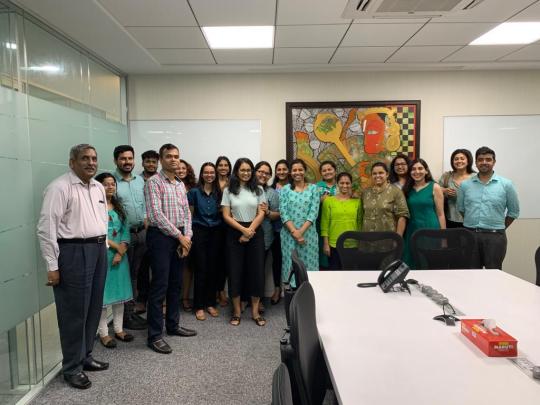#corporatelawfirmsinmumbai
Text

With a core objective of delivering supreme litigation advice, Khaitan Legal Associates is the epitome of India's law firms.
0 notes
Text
Renowned for their ability to grasp the overt and covert intentions of their clients, Khaitan Legal Associates provide a level of legal service that places them at the forefront of Mumbai's law firms.
0 notes
Photo

Looking for the top corporate law firms in mumbai? Khaitan Legal Associates could be the best choice.
0 notes
Text

Looking for a team of top lawyers in Mumbai? Khaitan Legal Associates is one of the best innovative law firms.
0 notes
Video
undefined
tumblr
Looking for the complete deets on Insolvency Resolution of personal guarantor? Check out the insights section of Khaitan Legal Associates - one of the top law firms in mumbai
0 notes
Text
Resolving the NPA Conundrum: Bad Bank to the Rescue

The Launch
Indian policymakers have wrestled for more than a few decades to solve the twin balance sheet problem of overleveraged companies and bad-loan-encumbered banks. Indecisiveness, delays in resolution of bad loans and reaching consensus have resulted in unprecedented challenges. Consequently, banks evergreen non-performing assets (“NPAs”) while credit and investment functions take a back seat. Taxpayer’s money is put to risk as public sector banks breach solvency and need to be recapitalized by the Government. Various agencies such as CRISIL and ASSOCHAM have signaled the rise of gross NPAs of banks to 8–9% in the fiscal 2021–22 and stressed assets to 10–11%. The regulator itself has indicated a sharp increase in NPAs of scheduled commercial banks to 9.5% by September 2022.
Currently, the legal framework for resolution of NPAs include the Securitization and Reconstruction of Financial Assets and Enforcement of Security Interest Act, 2002 (“SARFAESI”), resolution frameworks released by the Reserve Bank of India (“RBI”) and the Insolvency and Bankruptcy Code, 2016 (“Code”). The Code has to a large extent dealt with the problem of businesses overleveraging assuming there will be no consequence of default. The Code also facilitates businesses functioning as a going concern while the resolution of NPAs is effected.
In this backdrop the Government has now created a new mechanism to deal with the NPA problem — the “Bad Bank”. The idea to have a centralized public sector asset rehabilitation agency was conceived through the Economic Survey in 2016–17. It was proposed that the Bad Bank would take charge of the largest and most difficult NPAs and make politically tough decisions to reduce NPAs. In 2017, Dr. Viral V Acharya, Deputy Governor, RBI, in his speech highlighted potential of a bad bank to resolve NPA induced stress in the economy. Finally, in the Union Budget 2021–22, the Government announced creation of an asset reconstruction company (“ARC”) and an asset management company (“AMC”) to implement such recommendations. The intention is that the ARC consolidates and takes over the existing NPAs of public sector banks and the AMC manages and disposes of such NPAs to entities such as alternative investment funds and other potential investors, unlocking value.
2. Regulation and Function
Pursuant to the budget announcement, the Government has incorporated the National Asset Reconstruction Company Limited (“NARCL”). It is said that NARCL will acquire NPAs worth INR 2 lakh crore from various commercial banks in a phased manner. Additionally, the India Debt Resolution Company Ltd (“IDRCL”) has also been set up with the purpose of selling such NPAs in the market. The twin structure of NARCL-IDRCL is proposed to be the “Bad Bank”. NARCL is registered as an ARC and will be regulated by the RBI under the auspices of SARFAESI.
It is proposed that NARCL will purchase NPAs from public sector banks by paying 15% of the agreed price in cash and for the remaining 85%, NARCL will issue security receipts. It is further proposed that IDRCL will be responsible for resolution and sale of such NPAs. The consequent receipts will be utilized to redeem the security receipts. The Government will provide credit support to the Bad Bank through a guarantee of INR 30,600 crore for 5 years, guaranteeing recovery of such NPAs. Accordingly, the structure ensures the highest credit rating for the security receipts issued by NARCL, while differing the obligation of the Government to recapitalize public sector banks.
3. The Regulatory Roadblock
“Asset Reconstruction” as defined in Section 2 (1) (b) of SARFAESI, provides for the acquisition and resolution function of an ARC under the same legal entity. Accordingly, the RBI has recently opposed the proposed dual structure (i.e., one arm that acquires assets (NARCL) and the other arm that resolves such assets (IDRCL)) of the Bad Bank due to lack of statutory powers to regulate the same under SARFAESI. It is also not clear what will be the valuation/transfer price of NPAs from NARCL to IDRCL.
To overcome this issue, a principal-agent relationship between NARCL and IDRCL is being proposed. Under this agency, it is proposed that NARCL will engage IDRCL and outsource resolutions of NPAs (which would not be binding on NARCL) to IDRCL.
In the first structure elucidated above, there is lack of clarity on the relationship between NARCL and IDRCL and also on statutory sanctity. The second structure provides for a principal-agent relationship between the two. At the outset, the second structure, by virtue of the inherent nature of the “principal-agent” relationship, makes IDRCL accountable to NARCL. Whenever the relation of agency is created, there attaches prima facie to each party a number of duties, liabilities and disabilities-the normal incidents of agency.
In this context, the example of South Korean “bad-bank” structure adopted during the Asian Financial Crisis of 1997 is worth mentioning. At that time, South Korea’s NPAs stood at a glaring 18% of total loans, against present best-in-class 0.5%. The bad bank was called Korea Asset Management Corporation (“KAMCO”) which was state backed with a 5-year sunset window. However, it was not just the KAMCO structure which resolved the NPA stress, South Korea also adopted various other policy measures. These included harmonized information technology system for reporting NPAs by banks, online platform for auctions of NPAs, database of recoveries based on past auction and court-recovery results, which helped provide future basis for pricing NPAs and formula-based pricing to minimize valuation disagreements.
4. Conclusion
While ARC’s have been in existence since early 2000, the proposed “Bad Bank” backed by the guarantee of the Government of India ensures transferring banks will receive the amounts committed by NARCL and perhaps more, thereby resulting in a tradeable security of the highest credit rating and an indirect recapitalization of the transferring bank by the Government. The structure also frees the Bad Bank to deal with purchased NPAs without interference from transferring banks and permits a controlled wind down of such NPAs including through resorting to IBC proceedings or by creating a market for purchase of stressed assets by interested parties, thereby resulting in value maximization. Additionally, the structure will also permit closer interactions with the Government and facilitate policymaking, based on experiences and market demand.
If history is any guidance, there will be gaps between intention and implementation. This is a space to watch. Were the Bad Bank to succeed in cleaning up the NPA mess as intended, the results are for all to see in the South Korean example.
0 notes
Text
Top Corporate Law Firms In Mumbai
Khaitan & Co is one of the Best Corporate Law Firms in India specialise in providing top commercial legal advice and company law services in Mumbai to startups, established businesses and the people who run them.
0 notes
Text
Corporate Dispute Resolution in India: Arbitration vs. Litigation
Most businesses have ties with corporate law firms in Mumbai to avoid conflicts, and they typically suggest two common options for resolving legal disputes in the corporate ecosystem- arbitration and litigation.

0 notes
Photo

Check out this insightful details in brief at one of the top law firms in mumbai - Khaitan Legal Associates.
0 notes
Text
How Corporate Law Firms Are Helpful to Companies Interested in Working as Multinational Entity
Decription : If yes, you can reach Indian corporate lawyer and know how to fulfil legal requirements for accomplishing the expansion mission.
Please Visit Here : https://www.reddit.com/user/anjalishekhaw/comments/16mkkul/how_corporate_law_firms_are_helpful_to_companies/
#corporatelawfirmsinMumbai #Indiancorporatelawyer
0 notes